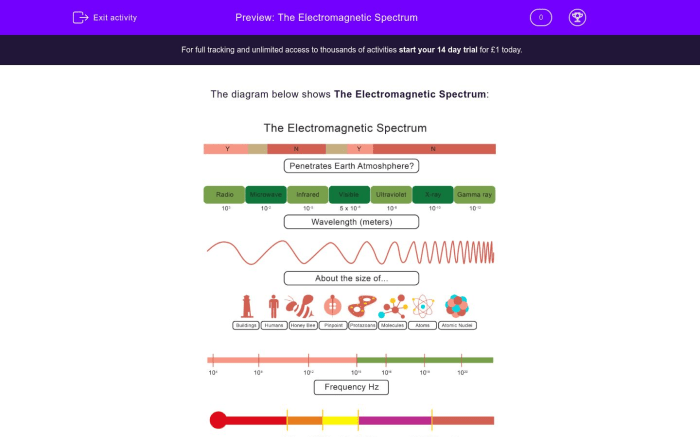Science 8 Electromagnetic Spectrum Worksheet embarks on an enlightening journey into the captivating realm of electromagnetic waves. This comprehensive resource delves into the fundamental concepts, properties, and applications of this multifaceted phenomenon, providing a solid foundation for students to grasp the intricate workings of our technological world.
Prepare to unravel the mysteries of the electromagnetic spectrum, from its diverse range of waves to its profound impact on our daily lives. Discover the fascinating properties that govern these waves, including wavelength, frequency, and energy, and witness how they interact with matter in remarkable ways.
1. Electromagnetic Spectrum Overview

The electromagnetic spectrum encompasses a vast range of energy and frequencies, extending from low-frequency radio waves to high-energy gamma rays. It is a fundamental component of our universe, playing a vital role in many natural phenomena and technological applications.
The electromagnetic spectrum can be visualized as a continuous band of waves, with each type of wave characterized by its wavelength and frequency. Wavelength refers to the distance between two consecutive peaks or troughs of the wave, while frequency measures the number of oscillations per second.
Types of Electromagnetic Waves
- Radio waves: Longest wavelength, lowest frequency; used in communication, navigation, and remote sensing.
- Microwaves: Shorter wavelength, higher frequency than radio waves; used in cooking, communication, and medical imaging.
- Infrared radiation: Wavelengths longer than visible light but shorter than microwaves; used in thermal imaging, remote sensing, and heating applications.
- Visible light: Wavelengths visible to the human eye; used in photography, communication, and everyday vision.
- Ultraviolet radiation: Wavelengths shorter than visible light but longer than X-rays; used in sterilization, disinfection, and medical imaging.
- X-rays: Wavelengths shorter than ultraviolet radiation; used in medical imaging, security screening, and crystallography.
- Gamma rays: Shortest wavelength, highest frequency; used in medical imaging, radiation therapy, and astrophysics.
2. Properties of Electromagnetic Waves: Science 8 Electromagnetic Spectrum Worksheet

Electromagnetic waves exhibit several fundamental properties that govern their behavior and interactions with matter. These properties include wavelength, frequency, and energy.
Wavelength, Frequency, and Energy
Wavelength, frequency, and energy are inversely related, meaning that as wavelength increases, frequency decreases, and vice versa. Energy is directly proportional to frequency, so higher-frequency waves have more energy than lower-frequency waves.
The relationship between wavelength, frequency, and energy can be expressed mathematically as: “` E = h – f = h – c / λ “` where: – E is energy in joules (J) – h is Planck’s constant (6.63 × 10^-34 J s) – f is frequency in hertz (Hz) – c is the speed of light (3 × 10^8 m/s) – λ is wavelength in meters (m)
3. Interactions of Electromagnetic Waves with Matter
When electromagnetic waves interact with matter, they can undergo various interactions, including reflection, refraction, absorption, and transmission.
Reflection, Science 8 electromagnetic spectrum worksheet
Reflection occurs when electromagnetic waves bounce off a surface without penetrating it. The angle of reflection is equal to the angle of incidence, and the wave’s properties remain unchanged.
Refraction
Refraction occurs when electromagnetic waves pass from one medium to another, causing them to bend or change direction. The amount of refraction depends on the wavelength of the wave and the refractive indices of the two media.
Absorption
Absorption occurs when electromagnetic waves are absorbed by matter, converting their energy into other forms such as heat or electrical energy. The absorption coefficient of a material determines how much radiation it absorbs at a given wavelength.
Transmission
Transmission occurs when electromagnetic waves pass through a material without being significantly absorbed or reflected. The transmittance of a material measures the fraction of radiation that passes through it.
Question Bank
What is the electromagnetic spectrum?
The electromagnetic spectrum encompasses the entire range of electromagnetic waves, including radio waves, microwaves, infrared radiation, visible light, ultraviolet radiation, X-rays, and gamma rays.
How do electromagnetic waves interact with matter?
Electromagnetic waves can interact with matter through reflection, refraction, absorption, and transmission. These interactions depend on the wavelength of the wave and the properties of the material.
What are some applications of the electromagnetic spectrum?
The electromagnetic spectrum finds applications in various fields, including communication, medicine, scientific research, and remote sensing.